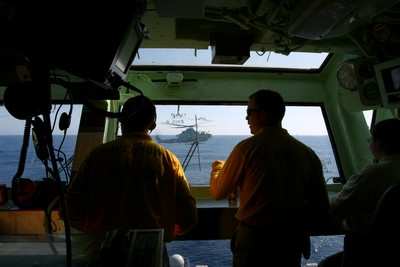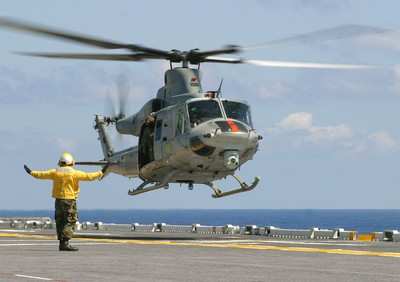The Marine Corps' newest utility and attack helicopters, the
UH-1Y and AH-1Z, made their first shipboard landings May 7 while
conducting shipboard compatibility testing, or "sea trials."

Operating aboard the Multipurpose Amphibious Assault Ship USS
Bataan off the Virginia Capes, the two aircraft made 267 landings
during nearly 30 flight hours in both day and night operations to
test their ability to operate in the shipboard environment.
Program officials are satisfied with the results.

"We met all the test objectives we hoped to accomplish," said
Matt Funk, the
H-1 lead flight test engineer for sea trials testing. "The idea was
to verify shipboard compatibility by looking at the aircraft's
ability to operate in the maritime environment and during all
aspects of shipboard operations."
The testers weren't completely happy, though...
"The weather was too good," he explained. "We conducted launch
and recovery operations in winds up to 35 knots over the deck. The
only thing preventing testing in higher wind conditions was a lack
of higher winds."
Despite the curse of beautiful weather, partially salved by the
Bataan's mess serving the flight test crew lobster and steak meals
while aboard, testers put the two aircraft through a wide array of
tasks designed to evaluate the aircraft's degree of marinization,
including day and night aided and unaided launches and recoveries,
refueling, shipboard handling (with the ship pitching and rolling
in the ocean swells), rotor blade folding and unfolding in winds up
to 25 knots, and flight deck crew familiarization training.

"The whole idea was to demonstrate the platform's marinization,"
explained Lt. Col. David Anderson, the H-1 program's assistant
program manager for systems engineering. "We need to know that when
we go aboard the boat, we can live there. The test team did just
that."
As Marine Corps aircraft, the AH-1Z and UH-1Y must be marinized
to support the Corps' mission of assault from the sea.
"Marinization" refers to the unique capability of Navy and Marine
Corps aircraft to withstand the daily punishment of temperature
extremes, salt water, high structural loads and harsh conditions
associated with shipboard/austere location operations in the
expeditionary environment.
Specific aspects of marinization can include blade and tail
folding, ruggedized avionics and airframe structure, improved
corrosion resistance for both the aircraft and support equipment,
ability to withstand salt water ingestion by the engines, and close
quarters deck-handling ability.

To date, the H-1 Upgrades program has more than 2,900 flight
test hours tallied since Dec. 7, 2000. Other current testing
includes AH-1Z weapons accuracy testing at the Army's Yuma Proving
Ground in Arizona and UH-1Y firing loads and vibrations testing
here. More than 870 2.75-inch rockets have been fired during
testing, as well as 13,662 rounds of machine gun and automatic
cannon ammunition, 11 Hellfire anti-armor missiles and three AIM-9
Sidewinder air-to-air missiles.
The AH-1Z and UH-1Y are slated to replace the current fleet of
AH-1W and UH-1N aircraft which have been operating at sea with the
Marine Corps for many years. The H-1 program provides over 80%
parts commonality for the two aircraft.
A change to the program that will build UH-1Ys completely new,
rather than remanufacturing them from aging UH-1N's, received
approval by the Defense Department's acquisition chief in April
2005. The first new build UH-1Ys will start production in 2006 as
part of the third lot of low-rate initial production aircraft.
First deliveries of the new aircraft are scheduled to begin in
2008.

Currently, 10 UH-1Y and six AH-1Z aircraft are in production at
Bell Helicopter's Fort Worth and Amarillo, Texas facilities. By
2014, the Marine Corps will have procured 100 UH-1Y Hueys and 180
AH-1Z Super Cobras. [ANN Thanks John Milliman, H-1 Program Public
Affairs, NAVAIR]
 ANN's Daily Aero-Linx (04.16.24)
ANN's Daily Aero-Linx (04.16.24) Aero-News: Quote of the Day (04.16.24)
Aero-News: Quote of the Day (04.16.24) Airborne 04.10.24: SnF24!, A50 Heritage Reveal, HeliCycle!, Montaer MC-01
Airborne 04.10.24: SnF24!, A50 Heritage Reveal, HeliCycle!, Montaer MC-01 Airborne 04.12.24: SnF24!, G100UL Is Here, Holy Micro, Plane Tags
Airborne 04.12.24: SnF24!, G100UL Is Here, Holy Micro, Plane Tags Airborne-Flight Training 04.17.24: Feds Need Controllers, Spirit Delay, Redbird
Airborne-Flight Training 04.17.24: Feds Need Controllers, Spirit Delay, Redbird







